
This section contains annotations of works that cover one or more of the branches of Slavic (East, West or South) and items about proto-Slavic and comparative Slavic. The resources below may be published in any Western or Slavic language. Resources that are about particular Slavic languages will be annotated on the pages dealing with those topics. Items about linguistics in general, not necessarily about Slavic linguistics, will be found on the pages devoted to the languages in which they are published. For example, the bibliography Strukturnoe i prikladnoe iazykoznanie is a Soviet/Russian bibliography on structural and applied linguistics. The subject matter is a linguistics topic in general, but the bibliography itself appears in Russian, so it is discussed on the page entitled Resources for Russian Linguistics. Cross references are provided for works that could be listed under multiple categories.
Linguistics is a good example of a discipline in which the bibliographic resources are not necessarily produced according to the common arrangement of the field. For example, scholars often become specialists in one branch of Slavic, courses are taught on the common linguistic features of one branch, but there are comparatively few bibliographic items devoted to just one Slavic branch. Usually the sources cover all of Slavic or a particular language. Within the sources for all of Slavic linguistics, however, material is commonly arranged by branch. In addition to the bibliographic genre sections, this page contains sections for materials on each branch (if any pertinent resources have been found) as well as a section detailing resources for Balkanistika. Separate pages for each language are under development. As is true for all of the pages in this course, clicking on either portraits or names of bibliographers and authors will lead to their biographical data.
Bibliographies of Bibliographies
Be sure to check general bibliography of bibliographies and guides to the resources for whatever country/language you are researching, for almost all of them have sections on language or linguistics.
Bibliographie der Bibliographien zur slavischen Sprachwissenschaft.
 Schaller, Helmut Wilhelm. Frankfurt am Main: Verlag Peter Lang, 1982. 115 p. (Symbolae Slavicae; Band 15).
Schaller, Helmut Wilhelm. Frankfurt am Main: Verlag Peter Lang, 1982. 115 p. (Symbolae Slavicae; Band 15).
U of I Library Call Number: International & Area Studies General Slavic Reference (Slavic) 016.4918 Sch14b
This source covers bibliographies of various aspects of Slavic linguistics, with most sources having been published in the 20th century and just a few 19th ones included. The introduction gives a brief overview of earlier attempts at compiling such a bibliography and a short section within the body of the work also covers bibliographies of Slavic bibliographies. The citations, which are for bibliographies published as books and articles, are arranged into several sections such as General, Bibliographies for Institutions, bibliographies devoted to a particular branch of Slavic or a particular language, among others.Unfortunately, there are no annotations, but there are indexes for authors, periodicals, subjects of bio-bibliographies, and subjects. See the image below for the first few items listed for Sorbian.

Bibliography of bibliographies of the languages of the world. Volume 1. General and Indo-European languages of Europe.
Troike, Rudolph C. ed. Amsterdam/Philadelphia: John Benjamins, 1990. (Amsterdam studies in the theory and history of linguistics science. Series V, Library and information sources in linguistics ; v.19)
U of I Library Call Number: Oak Street Facility 016.41 Am88 v.19
The last 150 pages of this bibliography of bibliographies covers the various languages of Eastern Europe and the Balkans. There are sections for every Slavic language and OCS as well as Albanian, Romanian, Greek, Latvian and Lithuanian. There are also sections for Eastern Europe in general, Balto-Slavic, and Baltic. Hungarian and Estonian are not covered because they are not Indo-European languages. The entries, some of which are briefly annotated, are arranged alphabetically within each language section. There are also name and subject indexes. See the entries below which appear in the Polish section.
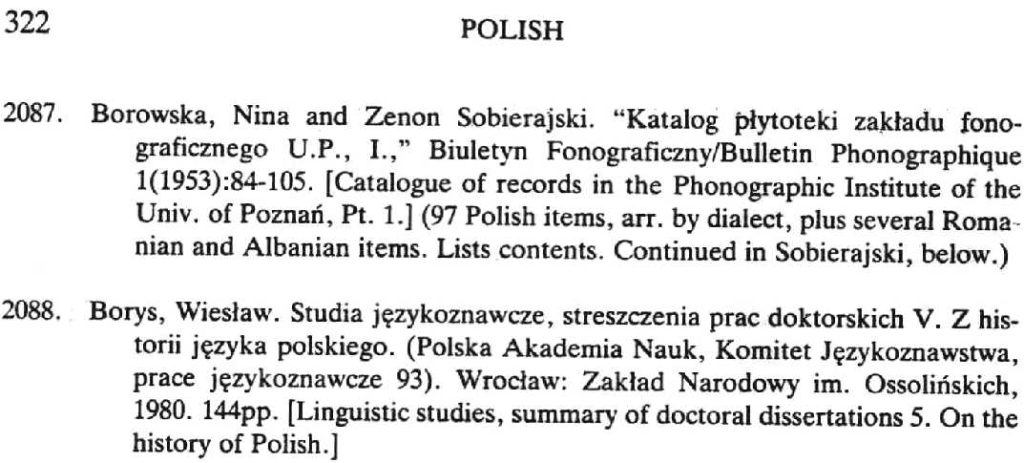

Slawistische Fachbibliographien aus der Deutsche Demokratischen Republik 1945-1969.
Fritsch, Helmut. Jena: 1974. 67 p. (Bibliographische Mitteilungen der Universitatsbibliothek Jena ; n.14).
U of I Library Call Number: International & Area Studies General Slavic Reference (Slavic) and Oak Street Facility 016.4918 F91s
This short bibliography of subject bibliographies published in DDR has sections on each Slavic language and literature. It includes bibliographies published as separate books, as articles, and at the end of books and articles. There are no annotations, but there is an author/compiler index. See the entry below for a bibliography of East German dissertations in the area of Slavic studies.


Slavic linguistics. A bibliographic guide to materials in the University of Virginia Library.
Collins, Daniel E. and Angelika S. Powell. [Charlottesville, VA]: [UVA], 1987. 207 p.
U of I Library Call Number: International & Area Studies General Slavic Reference (Slavic) 016.4918 Un3s
Although this bibliography is not annotated and only covers the resources available at one university library, it nevertheless is a handy listing of different types of linguistic resources for all of the Slavic languages. For example, there is a section for general periodicals and serials for every language as well as one for dictionaries. Monographs are listed by topic under each language. Thus, there are sections covering the history of each language, the phonology, morphology, dialectology, and the syntax of each one, and other topics. There is a name index at the back. See the image below for some entries that appear under the heading of “Dravano-Polabian and other Extinct Lechitic Languages – Dictionaries.”


Bibliographies for Slavic Linguistics
See also the serial bibliography Novaia literatura po sotsial’nym i gumanitarnym naukam. Iazykoznanie which appears in the Russian linguistics part of this course, for it has sections on each Slavic branch and each Slavic language.
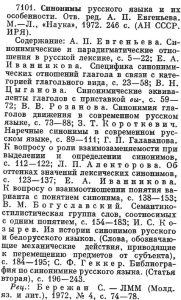
Slavianskoe iazykoznanie. Bibliograficheskii ukazatel’ literatury izdannoi v SSSR c … po … gg.
Moskva: Izd-vo Akademii nauk SSSR, 1963-1980.
U of I Library Call Number: International & Area Studies Russian Reference (Slavic) 016.4918 Ak1s v.1-5 + v.5, chast’ 2 016.4918 B883sla. 1976-1978 International & Area Studies Russian Reference (Slavic) 016.4918 B883sl v.1-3. International & Area Studies Russian Reference (Slavic) 016.4918 B883s v.1-4 (1979-1981)
Covering 1918-1981 in 13 physical volumes, this bibliography includes citations for articles, books, and reviews published in the Soviet Union about Slavic languages. For anthologies the entire table of contents is provided. The first 2 volumes alone contain over 14,000 entries. Each volume is divided into several main sections such as the History and Current State of Slavic Linguistics, Slavic Languages, Slavic and Non-Slavic Languages, Applied Linguistics, with many subdivisions under each main section. There are, for example, sections on famous linguists and on each Slavic language with subsections for dialectology, the literary language, stylistics, etc. Use the detailed table of contents and the index of names and titles to find citations on the topic of interest. Although this bibliography is about all of the Slavic languages, the majority of the citations concern Russian and East Slavic, probably because the works cited are only by Soviet scholars. Volume 1 covers 1918-1960, volume 2:1956-1960, volume 3:1961-1965, volume 4:1966-1970, volume 5:1971-1975. 1976-1978 and 1979-1981 have similar arrangements, but are published in multiple volumes. See the entry on the left for the contents of the anthology Sinonimy russkogo iazyka i ikh osobennosti and a citation for its review.

A Selected Bibliography of Slavic Linguistics.
Stankiewicz, Edward and Dean Worth. The Hague: Mouton, 1966-1970. 2 vols.
U of I Library Call Number: International & Area Studies General Slavic Reference (Slavic) and Main Stacks 016.4918 St2s v.1-2
Although this bibliography is almost 35 years old, it is still an important source, for the editors are renowned Slavic linguists and they selected what they felt to be the most relevant works (books and articles) published up to 1962 on a variety of topics in the discipline of Slavic linguistics. In place of annotations the editors have provided references to reviews of books. The contents are divided into several sections: General which encompasses the origins of the Slavs, Balto-Slavic, Common and Comparative Slavic; Old Church Slavic and Recensions; and sections for each branch, West, South, and East Slavic as well as sections for each individual Slavic language. Within these sections are applicable subdivisions for synchronic and diachronic studies, dialectology, onomastics, the development of the standard language and others. There is an author index at the end of each volume. See the entry below for Diels Altkirchenslavische Grammatik and its reviews.


Kommentierte Bibliographie zur Slavischen Soziolinguistik.
Brang, Peter and Monika Züllig. Bern: Peter Lang, 1981. 3 vols. (Slavic Helvetica ; Bd. 17).
U of I Library Call Number: Main Stacks 016.40190947 B734k v.1-3
This massive compilation of more than 15,000 citations covers articles, books, reviews, and dissertations published in all of the Slavic languages and some western ones on the topic of sociolinguistics. The citations in western languages are for works specifically about sociolinguistics and some Slavic language, whereas those in Slavic languages may be about sociolinguistics in general. The arrangement of the bibliography is by broad subject category such as language and social structure or language and culture, with subcategories under each main subject. Use the table of contents and the subject index to do more specific searching. The scope of included citations is the 19th and 20th centuries, but most of them are for 20th century publications. Not all of the entries are annotated, and of those that are, some are detailed and others are extremely brief. The third volume contains the indexes for subjects and authors as well as the key to all the journal titles and other abbreviations. A capital R after a name in the index indicates a review citation. See the entry below that appears under the heading Language Politics.


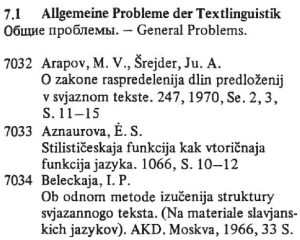
Handbibliographie zur neueren Linguistik in Osteuropa + Handbibliographie zur slavistischen und allgemeinen Linguistik in Osteuropa. 1963-1965, 1966-1971, 1972-1977.
Girke, Wolfgang, et al. Munchen: Wilhelm Fink, 1974 + Tubingen: Max Niemeyer, 1980-1988.
U of I Library Call Number: Oak Street Facility 016.41 G44h v.1-3:2
This bibliography covers work coming from all of the East European countries on the topics of linguistics and Slavic linguistics. It includes citations for books and articles, which are arranged by subject. The first section is devoted to bibliographies and then the general topics follow: development of linguistics, foundations of linguistics, phonemics, word forms and word formation, syntagmatics, textlinguistics, semantics, pragmatics, paralinguistics, lexicology, terminology, grammatical theory, computational linguistics, theory of translation, mathematical linguistics, statistical linguistics, linguistics and artificial languages, contrastive linguistics, typology, language teaching, psycholinguistics, sociolinguistics, linguistics change, and linguistic geography. Most of these subjects are further subdivided for easier use, but the arrangement cannot really substitute for a decent subject index which is sorely lacking in this work. Also disappointing for Slavists is that there are no sections for specific languages. The information on Russian will be found under every category, for example. There is an author index. In spite of its difficulties, this bibliography includes an enormous amount of material. See the titles list for the journals covered. The entries above appear in the section for text linguistics.

Bibliografie praci z oboru porovnavaciho studia slovanskych jazyku.
Praha: Kabinet cizich jazyku CAV, 1973. 239 p.
U of I Library Call Number: International & Area Studies General Slavic Reference (Slavic) 016.4918 B43b
This bibliography includes citations for books, articles and reviews about the study of Slavic languages. Czechoslovak works from 1945-1972 and works from other countries for 1960-1972 are organized into several main sections such as general characteristics of Slavic languages, Russian in comparison with the other Slavic languages, and comparative study of the Slavic languages. More specific categories further organize the material in each section. There are indexes for names and languages as well as a list of the journals from which many of the citations are extracted. See the entries below which appear in the subsection of Czech word formation and lexicon.
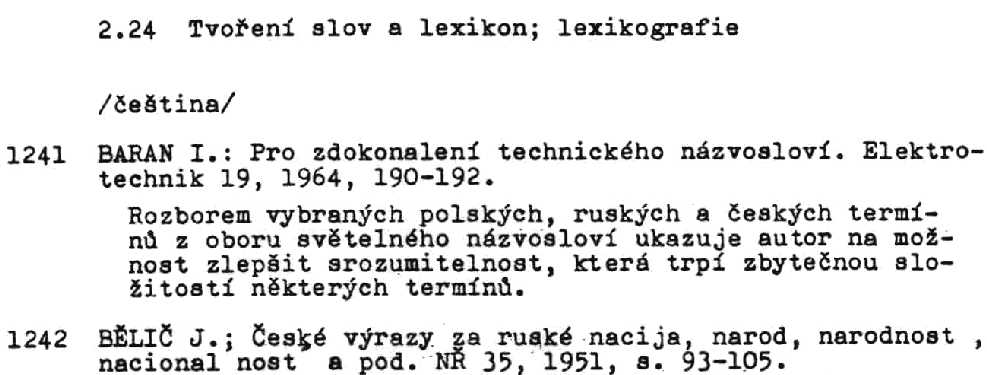

Bibliografia jezykoznawstwa slawistycznego za rok…
Warszawa: Slawistyczny Osrodek Wydawniczy, 1992-
U of I Library Call Number: International & Area Studies General Slavic Reference (Slavic) and Main Stacks Reference 016.4918 B4712 1992-1996
Covering books, articles, and reviews on all aspects of Slavic linguistics, this annotated, annual bibliography extracts citations from hundreds of publications world wide, most of which deal with Slavic studies or linguistics or both. Citations are arranged by subject with the general section coming first and sections for each Slavic language following. Within each language section there are further subsections such as phonology, sociolinguistics, stylistics, etc. There are indexes for authors and other people mentioned in the citations. At the end of each citation there is a note indicating the language of the item. See the citations below which appear in the 1995 volume under Czech Anthroponymy.
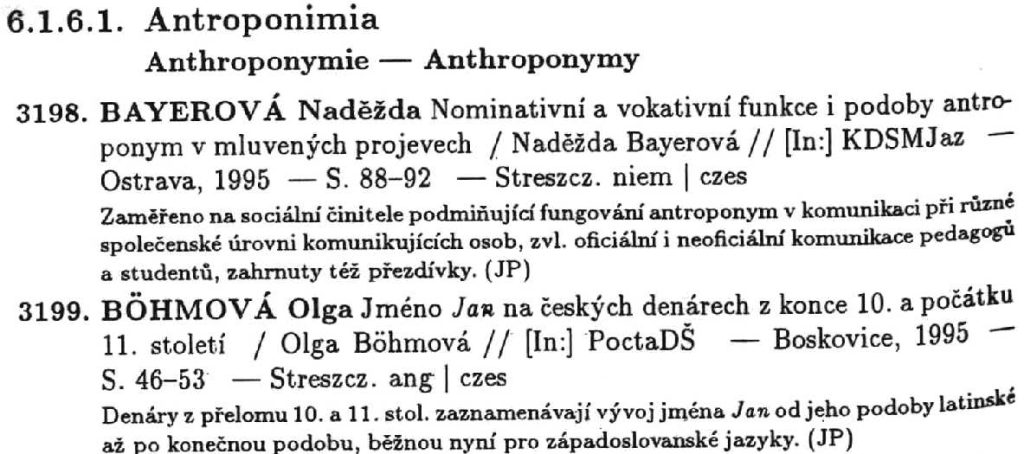

Lingvisticheskie atlasy. Annotirovannyi bibliograficheskii ukazatel’.
Sukhachev, N.L. Leningrad: BAN, 1984. 157 p.
U of I Library Call Number: Main Stacks 409 L647
This is an annotated bibliography of linguistic atlases for all the languages of the world. In this bibliography atlases are grouped by language family with Indo-European and its subgroups appearing first. Within the Indo-European section the Slavic languages appear first. There are separate sections for Slavic atlases and then atlases for each of the individual Slavic languages, including dialectal ones if available. Entries provide complete bibliographical data, details about the compilers, the territorial coverage, indexes, the number of maps, and other information. The bibliography has indexes for names, languages, places, and atlas titles. All annotations are written in Russian. See the entry below on a Belorussian atlas.
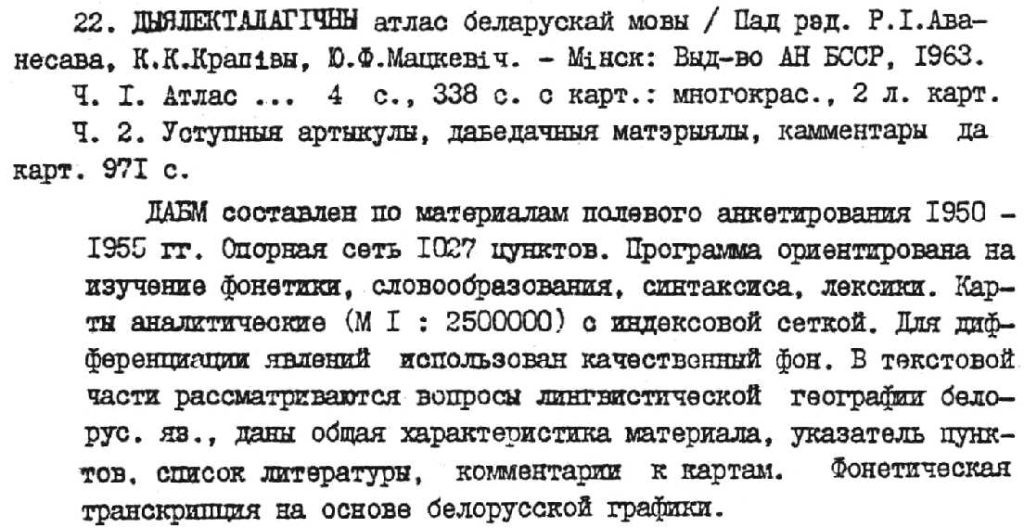
Periodical Indexes for Slavic Linguistics
Several of the titles annotated above in the Bibliographies section and below in the Slavistika section could be listed under Periodical Indexes as well since they extract data from numerous linguistics journals. See also Novaia literatura po sotsial’nym i gumanitarnym naukam. IAzykoznanie which is annotated in the section for Russian. Keep in mind also the various online databases to which the University of Illinois or your library subscribe that may be of use such as MLA or ABSEES or Linguistics and Language Behavior Abstracts (LLBA). MLA in particular contains a lot of vernacular language material.
East European languages and literatures. A subject and name index to articles in English-language journals, 1900-1977.
East European languages and literatures II. A subject and name index to articles in Festschriften, conference proceedings, and collected papers in the English language, 1900-1981, and including articles in journals, 1978-1981. + 1982-1984 + 1985-1987 + 1988-1990.
Terry, Garth M. Oxford: Clio Press, 1978.
Terry, Garth M. Nottingham, Eng.: Astra Press, 1982, 1985, 1988, 1991.
U of I Library Call Number: International & Area Studies General Slavic Reference (Slavic) and Oak Street Facility Q.016.4918 T279e + International & Area Studies General Slavic Reference (Slavic) and Main Stacks 016.4918 T279ea 1981, 1984, 1987, 1990
These five volumes compiled by Terry provide citations for English-language articles published in journals, Festschriften and conference proceedings from 1900-1990 that pertain to Slavic languages and literatures. Citations are arranged by subject such as East Slavonic languages, encyclopedias, transliteration, Sorbian studies, etc., as well as subject sections for each Slavic language, which are further subdivided by various linguistic themes as phonology, syntax, stylistics, languages in contact, etc. There is a name index, which gives access to authors and people as subjects, and a list of the journals from which the materials are extracted. See the image below for several entries that appear in the first volume under the heading “West Slavonic languages.”

Conference/Congress Bibliographies
Much of the literature in the field of Slavic linguistics stems from conferences and congresses. In fact, a number of bibliographies are produced which include citations for the works stemming from just one congress. Other works publish the actual papers themselves. How do you find the proceedings or other publications that result from these meetings? Fortunately, there are some bibliographies of international congresses that list the dates of the congresses and the corresponding publications. Two of them are glossed below. Another method for finding these materials is to search WorldCat using subject keywords such as linguistics congresses. You can also limit the results by language to narrow down the search.
Mezhdunarodnye kongressy po iazykoznaniiu. Bibliograficheskii ukazatel’.
Mezhdunarodnye kongressy po iazykoznaniiu. Bibliograficheskii ukazatel’. Vyp.1. Obshchee Iazykoznanie.
Korotkina, B.M. ed. Leningrad: Biblioteka Akademii nauk SSSR, 1973-1983 + 1987-
U of I Library Call Number: International & Area Studies Russian Reference (Slavic) 016.401 K84m v.1-2. Oak Street Facility 016.41 K843m v.1
Compiled by prominent Soviet philologists, the first volume of this source lists 456 international congresses that took place anywhere in the world on any topic in linguistics. It gives a chronology of the congresses beginning in 1838 and ending in 1978 and then arranges them by the subject of the congress. In the subject section publication information is provided for the materials that were produced as a result of each congress regardless of whether the materials were published in monographic or article format. Citations for reviews of those materials are also included. Indexes for the names of the congresses, locations, personal names, and subjects are provided to enhance access to the text. The compilers included only those materials held by Soviet libraries.
Volume two of this set details congresses devoted to Slavic linguistics beginning in 1903 and ending in 1986. The organization of the material is somewhat different. There is still a chronological listing of all the congresses, but rather than grouping by subject of the congress, it begins by grouping congresses by their sponsoring bodies. Congresses devoted to particular languages or branches of Slavic appear in section 6. What is particularly nice about this volume is that it lists not only publications of proceedings and papers, but also of bibliographies for the various congresses. There are indexes for places and personal names as well as a list of bibliographic resources that have been extracted from the main body of the book so that the user can locate the bibliographies without wading through the entire text.
Vypusk 1 of the second set with the same title is devoted to general topics on linguistics and extends the coverage to titles not necessarily held by libraries in the Soviet Union. It also discusses earlier attempts at producing bibliographies of this type in the Soviet Union and gives citations for those publications. The dates of the congresses range from 1909 through 1989. Bibliographies are not compiled into a separate list, but are treated the same as the other materials. The first section arranges materials by type of congress, for example, congresses of international associations and societies. The second section arranges the material by the subject of the congresses. The same indexes and chronology appear for this work as for those described above. See the entries below for publications resulting from a congress in Sofiia in 1976.
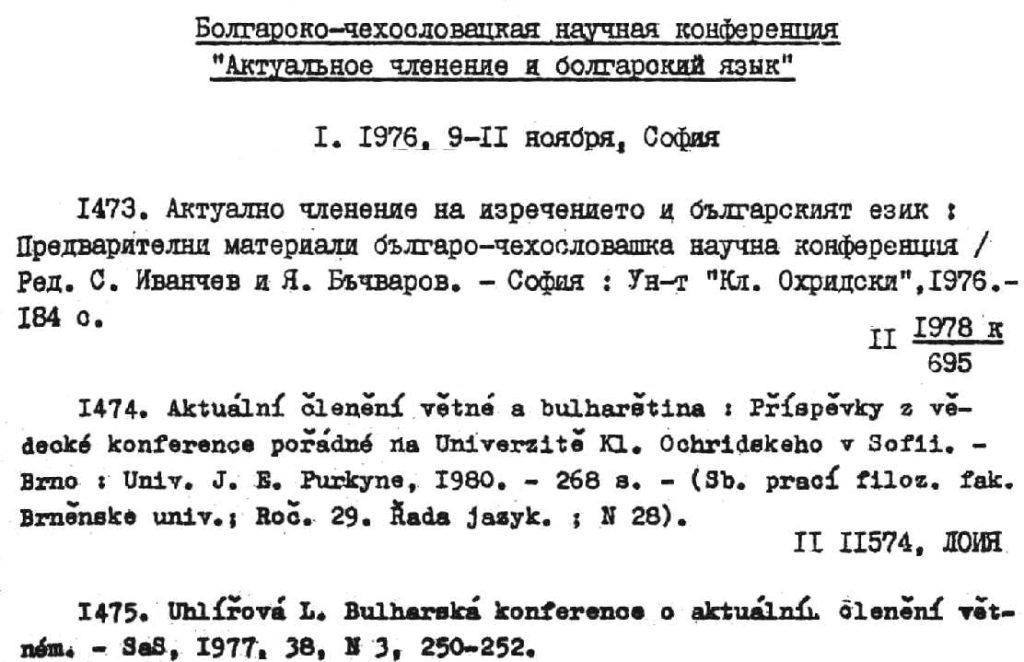
Slavistika
Under this heading can be found bibliographies that cover Slavistika produced by scholars in various Eastern European countries. Only a sampling of titles that exist are included below. Many of the citations in these sources are for linguistic items and items about teaching Slavic languages, but Slavistika covers Slavic literatures and cultures as well. If there are Slavistika bibliographies that publish separate volumes for each subject, linguistics and literature, only the linguistics volumes will be discussed below. Publications of Slavistika often are cataloged with the subject heading “Slavic philology”. Try searching WorldCat using that heading or keywords such as “slavistika” or “slawistika” to find other works in this category. Slavic studies–bibliography and Slavic countries–bibliography are other valid subject headings for this topic. Even Slavic countries–indexes or Europe, Eastern–indexes brings up some pertinent materials.
Novaia otechestvennaia i inostrannaia literatura po obshchestvennym naukam. Slavianovedenie i balkanistika. 1992.
Novaia sovetskaia i inostrannaia literatura po obshchestvennym naukam. Problemy slavianovedeniia i balkanistiki. 1976-1991.
Novaia literatura po obshchim problemam slavianovedeniia i balkanistiki. 1971-1975.
Novaia literatura po obshchim problemam slavianovedeniia. 1966-1970.
Moskva: INION, 1966-1992.
U of I Library Call Number: Main Stacks 016.4918 N85611. Main Stacks 016.4918 N8561. Main Stacks 016.4918 N8561. Main Stacks 016.4918 N856 [U of I lacks 1966-1970, 1976-1978, 1984]
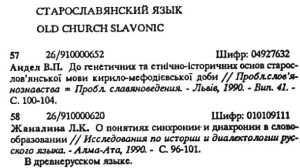 Published by INION, the social sciences branch of the Soviet Academy of Sciences, this serial presents citations for books and articles on the various topics associated with Slavic and Balkan studies from 1966-1992, after which it ceased. The citations are taken from works received at the Library of the Academy of Sciences, so it includes non-Soviet items as well. A large part of this bibliography is devoted to linguistics and language issues with sections devoted to grammar, dictionaries, the history of the Slavic languages, Old Church Slavic, etc. Although this title is supposed to be covered in the online Russian Academy of Sciences Bibliographics database, a number of random searches reveal that there are items in the printed version that do not appear in the database. Citations are arranged by subject. Use the table of contents to help navigate through the text. See the entries to the left which appeared in the 1991:4 issue under Old Church Slavic.
Published by INION, the social sciences branch of the Soviet Academy of Sciences, this serial presents citations for books and articles on the various topics associated with Slavic and Balkan studies from 1966-1992, after which it ceased. The citations are taken from works received at the Library of the Academy of Sciences, so it includes non-Soviet items as well. A large part of this bibliography is devoted to linguistics and language issues with sections devoted to grammar, dictionaries, the history of the Slavic languages, Old Church Slavic, etc. Although this title is supposed to be covered in the online Russian Academy of Sciences Bibliographics database, a number of random searches reveal that there are items in the printed version that do not appear in the database. Citations are arranged by subject. Use the table of contents to help navigate through the text. See the entries to the left which appeared in the 1991:4 issue under Old Church Slavic.

Bibliographie slawistischer Publikationen aus der Deutschen Demokratischen Republic … 1946-1986.
Berlin: Akademie Verlag, 1968-1989.
U of I Library Call Number: International & Area Studies General Slavic Reference (Slavic) 016.4918 P75bi. Main Stacks Reference 016.4918 G986b [U of I holds only 1968-1972 and 1978-1981]
The entire series of these bibliographies covers 40 years of scholarship on Slavistics published in DDR including the output from several Sorbian journals. Entries provide citations for books, articles, and dissertations. The content is arranged by broad subject categories such as the languages of the Slavs with subsections by language branch, the literatures of the Slavs, again subdivided by branch, and Slavic and Germano-Slavic onomastics. There is also a section on the history of Slavistics and Germano-Slavic cultural relations. None of the entries are annotated. There are author and subject indexes. See the entries below which appear in the section entitled Old Slavic.
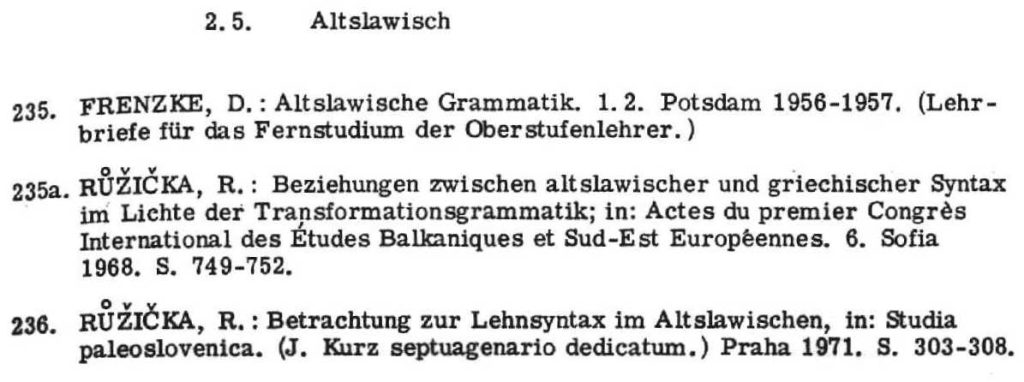

Bibliografie ceskoslovenske slavistiky 1961-1966.
Becka, J. a A. Vachouskova. Praha: Statni knihovna CSSR, 1968. 975 p.
U of I Library Call Number: International & Area Studies Czech/Slovak (Slavic) Reference 016.49186 B38b
Although this bibliography covers the histories and literatures of all the Slavic peoples, it is included here because of its large section devoted to Slavic languages and linguistics. It provides citations for books, articles, and reviews produced by Czech and Slovak scholars on Slavic studies from 1961-1966. The organization is by subject beginning with Slavistika and literature and then following with linguistics. The linguistics section has the same basic organization as other Slavistika bibliographies, i.e. a section for general topics and then sections for each Slavic language in turn. There is a name index at the end of the book. See the entries below that appear under the section for linguists.


Materialen zu einer slawistischen bibliographie. Arbeiten der in Osterreich, der Schweiz und der Bundesrepublik Deutschland tatigen Slawisten. 1945-1963. 1963-1973. 1973-1983.
Munchen: Verlag Otto Sagner, 1963, 1973.
U of I Library Call Number: International & Area Studies General Slavic Reference (Slavic) 016.4918 M27m. 016.4918 M27m ser.2 [U of I lacks 1973-1983]
For West German, Swiss and Austrian Slavistika, this is a useful bibliography of books, dissertations, articles, and reviews. There are sections devoted to each Slavic language which cover linguistics, literature, folklore and history as well as general sections including one for bibliographies. Unfortunately, the citations are not annotated, but there are indexes for subjects and authors. See the image below for some of the entries that appear in the 1945-1963 volume under Serbo-Croatian language.


Encyclopedias
Slavianskie drevnosti. Etnolingvisticheskii slovar’ v piati tomakh.
Tolstoi, N.I. red. Moskva: Mezhdunarodnye otnosheniia, 1995- . 5 vols.
U of I Library Call Number: International & Area Studies General Slavic Reference (Slavic) 305.8918 SL17 v.1-2
According to the introduction in this encyclopedia, ethnolinguistics examines language through the prism of human consciousness, traditions, mythological representations, etc. Thus, this interesting work presents Slavic mythology, folklore, religion, and antiquities with a linguistic focus. The entries, which have a comparative Slavic emphasis and often include linguistic details, are for concepts, items, or figures that appear in the spiritual Slavic world. For example, there are entries for the birch tree, wedding nights, specific saints, games, the color red, etc. The entries are often several pages in length with bibliographical references both in the body of the text and at the end and are signed by the scholars who wrote them. There are bibliographies of sources in each volume and lists of illustrations. The first volume contains a number of simple dialect and linguistic maps for various Slavic languages. To date only two volumes have been published up through the letter K. No entries are reproduced here because of their length.

Dictionaries
For information about dictionaries and bibliographies of Slavic dictionaries look at the more general Dictionaries and Sources for Dictionaries and Language Resources pages as well as the resources described below.
Dictionary of Slavonic linguistic terminology.
Jedlicka, Alois, ed. Praha: Academia, 1977. 2 vols.
U of I Library Call Number: International & Area Studies General Slavic Reference (Slavic) 491.803 Sl63 v.1-2
After a short investment of time to understand its arrangement, this dictionary can be extremely helpful to linguists. It lists 2266 basic linguistic terms used in all the Slavic languages and their English, French, and German equivalents. Volume One presents the terms grouped by subject. For example, all the terms related to syntax are given in one section and all the ones concerning style are given in another. Volume Two presents the terms alphabetically by language with the classification number for the appropriate section in Volume One. The introduction discusses the scholars who contributed terminology from the various languages. The languages are represented by a letter abbreviation and are presented in the same order for each term. It takes two consecutive, facing pages in order to cover one term in all 14 languages. See the entry below which shows the term “adverb” in Czech, Slovak, Polish, and Upper and Lower Sorbian.


Etimologicheskii slovar’ slavianskikh iazykov. Praslavianskii leksicheskii fond.
Trubachev, O.N. ed. Moskva: Izd-vo “Nauka”, 1974-
U of I Library Call Number: International & Area Studies General Slavic Reference (Slavic) 491.803 Et42 v.1-19, 21, 25-28 [U of I lacks v.20,22-24]
Produced by the Russian Academy of Sciences, this dictionary is still being published with 28 volumes having appeared to date (up through obp-). It presents a comprehensive lexicon of proto-Slavic based on comparative studies of words from all of the Slavic languages, including those that are now dead, and other world languages. The entries contain the posited form marked by an asterisk, followed by related words in the other languages and citations for their sources, and then often a brief discussion of details of the etymology and/or variant etymologies. Only native Slavic words are included, not loanwords. There is a list of sources used in the compilation of the dictionary at the beginning of the first volume and additional lists appear in various subsequent volumes as well. See the entry below for the verb *bobotati.
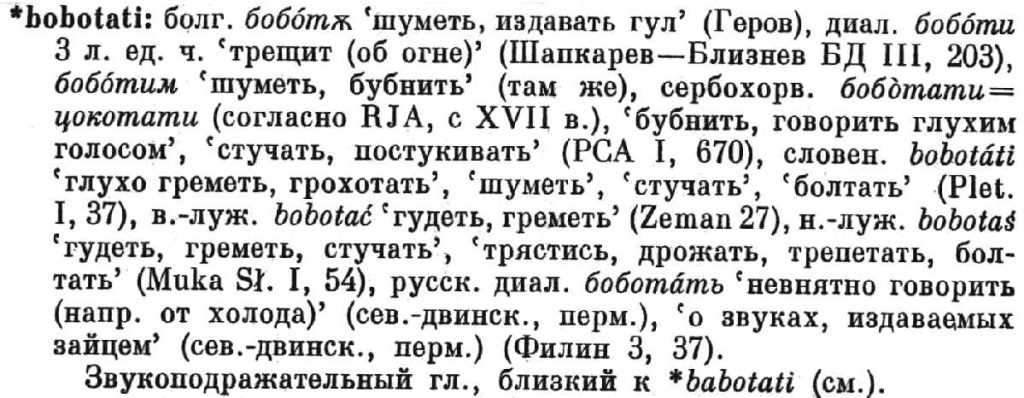

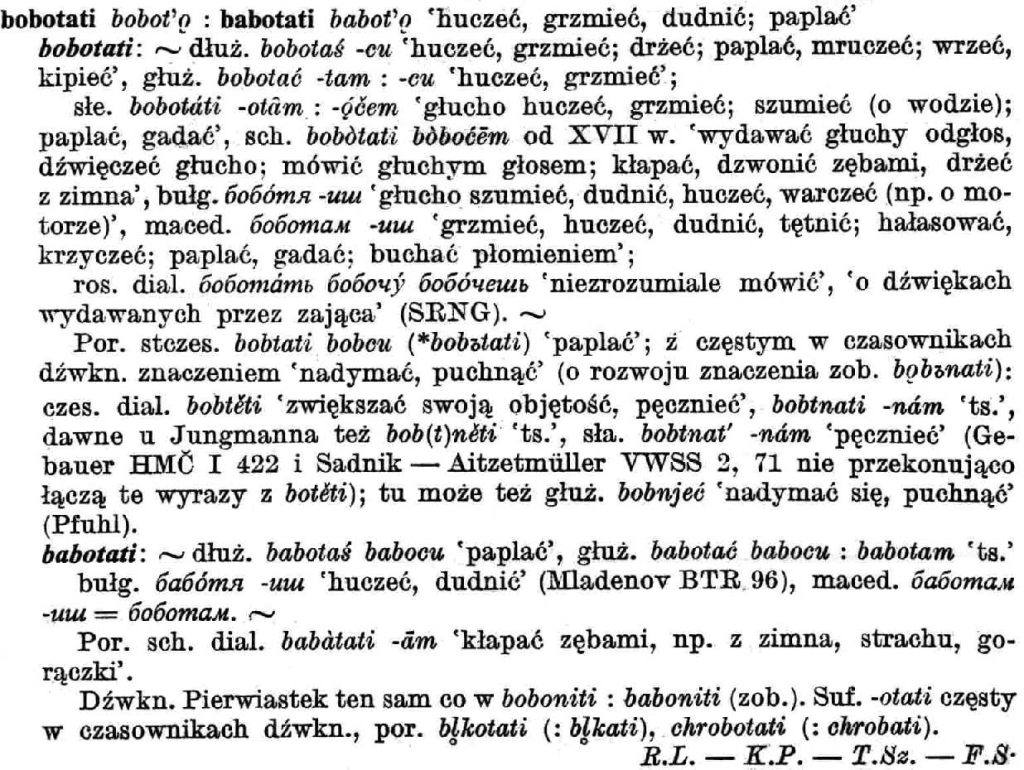
Slownik praslowianski.
Slawski, Franciszek, ed. Wroclaw: Polska Akademia Nauk, Komitet jezykoznawstwa, 1974- .
U of I Library Call Number: International & Area Studies General Slavic Reference (Slavic) 491.803 P76s v.1-8 [letters A-Gy]
Although only eight volumes have appeared to date (through the letter g), this dictionary of proto-Slavic, which is produced by the Polish Academy of Sciences, is another important dictionary for those doing comparative or historical Slavic linguistics. Entries provide a definition and related forms from other Slavic languages with citations to their sources. Articles are signed by their authors. The sources used to compile the dictionary are given in the first volume with several appended lists in subsequent volumes. There is less emphasis on Russian sources in this work than in the Russian Academy dictionary annotated above. Compare the two entries from both dictionaries for the same word “bobotati” to see the differences in the kind of information presented in the two works.

Etymologisches Worterbuch der Slavischen Sprachen.
Miklosich, Franz. Wien: Wilhelm Braumuller, 1886. 547 p.
U of I Library Call Number: Main Stacks 491.8 M589e
HathiTrust full text: http://hdl.handle.net/2027/mdp.39015058660773
Although this publication first appeared more than 100 years ago, it is still valuable because none of the subsequent etymological dictionaries of Slavic have covered the end of the alphabet yet the way this one does. Included are the OCS form as the main entry, German and Latin equivalents, and related forms in the modern Slavic languages. There is an index of all of the Slavic words that appear in the various entries and an appendix with additional entries at the end. Please note that no Cyrillic is used in this dictionary. Everything is given in transliteration or in the Latinate Slavic alphabets with the appropriate diacritics. See the brief entry below for the word “bobotati.” Most entries are considerably longer than this one.


Etymologicky slovnik slovanskych jazyku. Slova gramaticka a zajmena.
Havranek, Bohuslav and Frantisek Kopecny, eds. Praha: Academia, 1973-1980. 2 vols.
U of I Library Call Number: General Slavic Reference 491.803 Et94 v.1-2
Like the Russians and the Poles, the Czechs also have published an etymological dictionary of Slavic, but the organization and content of this one are quite different from the preceding two. Instead of a straight alphabetical order for all entries, the Czech dictionary divides the entries into parts of speech. For example, all of the first volume is devoted to prepositions and final particles while the second volume covers conjunctions, particles, pronouns, and pronominal adverbs. This dictionary does not supply entries for nouns, verbs, and adjectives. Entries, which can be extensive, give a definition, related forms in other languages, and often a discussion of the usage and etymology. Sources for given forms are cited with the source lists included at the beginning of both volumes. There are indexes at the end of each volume for words or forms cited in the dictionary from other languages such as Gothic, Old Indic, Old Prussian, etc. See below for the beginning of the 5-page entry on the adverb “jako.”
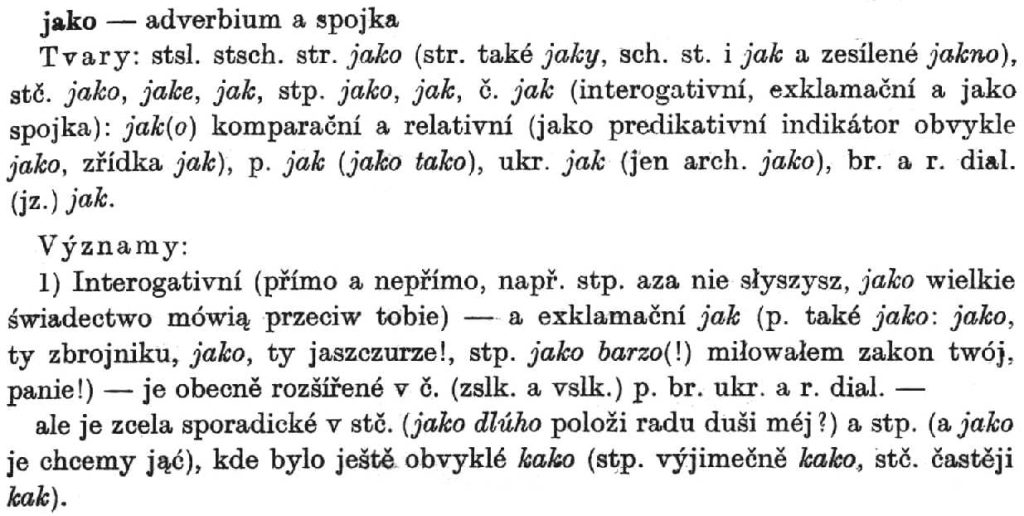

A dictionary of Slavic word families.
Herman, Louis Jay. New York: Columbia University Press, 1975. 667 p.
U of I Library Call Number: International & Area Studies General Slavic Reference (Slavic) 491.8 H42d
Basing the comparative tables on Russian, Polish, Czech, and Serbo-Croatian, this dictionary shows words derived from 200 of the most productive roots in Slavic. After each root table, which shows words derived from the root in each of the 4 languages with exact equivalents given on the same line in each of the columns, there is an explanation of the meaning of the root and derivational notes on some of the words in the table. All Slavic words are elucidated with an English translation. At the back of the book is a brief bibliography of sources and an index of roots divided by language. The introductory tables include one for prefixes and another for consonant changes. The image below shows the beginning of the table on the root for “measure.”
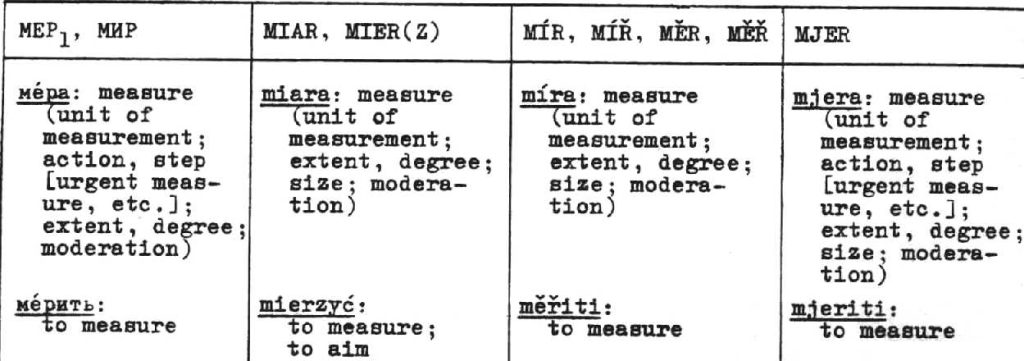

Grammars
For an annotated bibliography of Slavic grammars and dictionaries up to 1850, see Stankiewicz which is described in the Sources for Dictionaries and Language Resources section of this course.
The Slavonic languages.
Comrie, Bernard and Greville G. Corbett. New York: Routledge, 1993. 1078 p.
U of I Library Call Number: International & Area Studies General Slavic Reference (Slavic) and Main Stacks 491.8 Sl1633
This is a general guide to the Slavonic languages with an emphasis on their linguistic features. For those seeking a general introduction to these languages, this is a very good source and includes a basic bibliography on each language. For each language there are a transliteration table, an introductory section, a discussion of phonology, sections on syntax, morphology, and vocabulary, and a final discussion on dialects. For those beginning research in an unfamiliar language this can be a very useful source. Certainly, it is one that librarians can find very helpful when having to work with Slavic languages that are outside their main area of expertise.

Guide to the South Slavonic languages. Part 1.
Guide to the West Slavonic languages. Part 2.
Guide to the East Slavonic languages. Part 3.
de Bray, R.G.A. Columbus, OH: Slavica, 1980. 3rd ed., revised and expanded.
U of I Library Call Number: Main Stacks 491.8 D35g 1980 v.1-3
Before the publication of Comrie and Corbett’s The Slavonic languages, deBray’s work was the standard English-language reference handbook for the Slavic languages. It presents the grammar of each language in the same format beginning with an introduction on the development of the literary language and then covers the alphabet, pronunciation, Slavonic characteristics, features characteristic of each language, dialects, morphology, etc. The third edition is published in three separate volumes, one for each Slavic language branch. Brief bibliographies for each language appear at the beginning of every volume.

Biographical Sources for Slavic Linguistics
For biographical dictionaries about Russian linguists see the Biography Section in the Russian Linguistics guide of this course. The biographical section on Russian/Soviet academics lists sources that cover scholars and professors from all disciplines including linguistics. For pre-revolutionary Russian Slavists see Slavianovedenie v dorevoliutsionnoi Rossii. Biobibliograficheskii slovar’. For East Slavic in particular there is a source entitled Vostochnoslavianskie iazykovedy. There are a few sources for Czech slavists on the page for Czech/Slovak academics.
Most subject guides and bibliographies have sections entitled “Personalia” that list materials about the life and works of important individuals for a particular discipline. These citations often cover bio-bibliographies. In addition to using guides and bibliographies to find bio-bibliographies, try searching WorldCat using the surname of the individual and the word bibliography as keywords in the subject field. Below is an example of one work in the genre of bio-bibliography that appears in WorldCat when using this method to search for Roman Jakobson, arguably one of the most famous Slavic linguists ever, whose works are heavily studied in US Slavic departments.
Roman Jakobson 1896-1982. A Complete Bibliography of His Writings.
Rudy, Stephen. Berlin: Mouton de Gruyter, 1990. 187 p.
U of I Library Call Number: Internation & Area Studies General Slavic Reference (Slavic) 016.41 R886r
This chronological listing of all Jakobson’s works coordinates with the authoritative edition of his works, the 8-volume Selected Writings, by providing an SW citation for each item that appears in the bibliography so that it can be easily located in the set. Translations and reprintings of his works are cited below the reference to the original. In addition to the chronological list, there are the complete tables of contents of SW, indexes of titles, names, co-authors, periodicals, and major collections by language. See the entry below for his article “Musikwissenschaft und Linguistik.”


Trudy uchenykh filologicheskogo fakul’teta Moskovskogo universiteta po slavianskomu iazykoznaniiu. Bibliograficheskii ukazatel’.
Bernshtein, S.B. Nersesova, E.A. Moskva: Izd-vo Moskovsksogo universiteta, 1960-1979. 3 vols.
U of I Library Call Number: Oak Street Facility 016.4918 M853t v.1-3
This source presents bibliographies of noted Russians who worked in the field of Slavic linguistics who taught at Moscow University. It is not strictly a biographical source since it provides only full names and dates for the scholars, but it is arranged in such a way that the only access point for the material is via personal name. It has bibliographies of books and articles for each scholar with the items arranged chronologically. There are no indexes to provide access via subject or journal title, but if you happen to be looking for bibliographies of particular Russian slavists, this source may be helpful. Volume 1 ranges from the end of the 19th century to 1958, Volume 2 covers 1958-1967, and Volume 3 has 1968-1975.
South Slavic
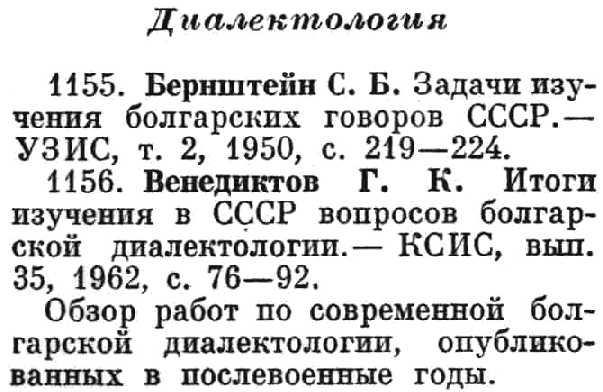
Iuzhnoslavianskie iazyki. Annotirovannyi bibliograficheskii ukazatel’ literatury opublikovannoi v Rossii i v SSSR s 1835 po 1965 gg.
Mozhaeva, I.E. Moskva: Nauka, 1969. 183 p.
U of I Library Call Number: International & Area Studies General Slavic Reference (Slavic) and Oak Street Facility 016.4918 M87i
Beginning with an overview of the sources in this field, this annotated bibliography covers 130 years of linguistic research by Russian and Soviet scholars on South Slavic languages and works by non-Russians who published in Russian or Soviet journals. It provides citations for articles, books, dictionaries, catalogs of manuscripts, and reviews. The first section annotates Russian bibliographies of Slavic studies which could be important since this bibliography makes no attempt at comprehensiveness. The other sections are for each of the South Slavic languages and for the South Slavic branch with subsections for various topics such as dialectology, syntax, etc. However, you won’t find a section devoted to OCS. Some works on that topic are covered in the section on South Slavic general works or under written monuments. There is also a section devoted to works about famous South Slavists. A name index and a list of sources consulted conclude the book. See the entries above which appear at the beginning of the Bulgarian dialectology section.
Balkanistika
This section presents Balkanistika, or, sources about the languages and cultures of the Balkan Peninsula. The Balkan languages include several that do not belong to the Slavic language family. Eventually, this course will annotate resources for those non-Slavic languages in their own sections, but for now the only resources which cover those languages will be some of those general ones discussed elsewhere on this page and some of those pertaining to the Balkans as a group that are annotated below.
To find other items of Balkanistika try searching WorldCat using some of the following subject words “Balkan Peninsula” and “Bibliography” or using the keyword “balkanistika.”
Balkan bibliography = Valkanike vivliographia.
Thessaloniki: Institute for Balkan Studies, 1973-1990.
U of I Library Call Number: Main Stacks 016.91496 B19 v. 4-12, 1975-1990 + supplements
Issued by the Institute for Balkan Studies in Greece, this bibliography has coverage of monographs and articles on all topics related to the countries of the Balkan Peninsula. There is a section for linguistics in each volume that appears under the Greek heading “glossologia.” All of the section headings, which represent the thematic arrangement of the citations, are in Greek as are the translations of titles written in the less commonly known languages such as Turkish and some of the Slavic languages. Citations are extracted from more than 500 journals published in all of the languages of the Balkan countries plus other European languages such as French, German and English. Supplemental volumes contain translations into Greek of selected articles. There are indexes of names for the bibliographic volumes. See the image below for some of the citations that appeared in volume 4 in the linguistics section under the heading “Albanian.”
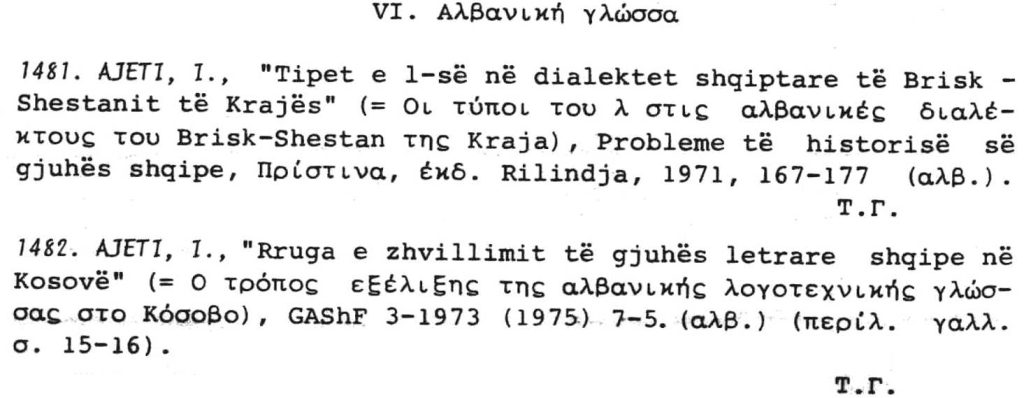

Bibliographie zur Balkanphilologie.
Schaller, Helmut Wilhelm. Heidelburg: Carl Winter, 1977. 109 p.
U of I Library Call Number: Main Stacks 016.4918 Sc1b
Although this bibliography is only about 100 pages long and leads you to believe by its title that it is about Balkan philology, it is solely about Balkan linguistics, not literature. References are to books and articles in all languages published in the 20th century, most of which appeared in print after 1940. The scope of the bibliography and criteria for selection are not made clear in the introduction. The citations are divided into sections for each Balkan language and subject categories such as the features of the Balkansprachbund or Balkan loan words. There are indexes for names and subjects. See the image below for a few entries that appear in the section on onomastics.


Linguistique Balkanique. Bibliographie 1966-1975.
Asenova, Petia. Sofia: Bulgarska Akademiia na Naukite, 1983. 265 p.
U of I Library Call Number: Main Stacks 016.409496 B199
Covering a decade of research, this bibliography offers citations for books, articles, and dissertations related to Balkan linguistics that were published in Bulgaria or in other countries. The entries are arranged by subject, with the first section covering bibliographies. Other subjects are typical of a linguistics bibliography: phonetics, phonology, morphology, lexicology, syntax, onomastics, etc. There are indexes for names and geographical locations plus a list of sources. Citations are not annotated, but references to reviews are included if available. See the image below which shows the beginning of the section entitled Verbal system.
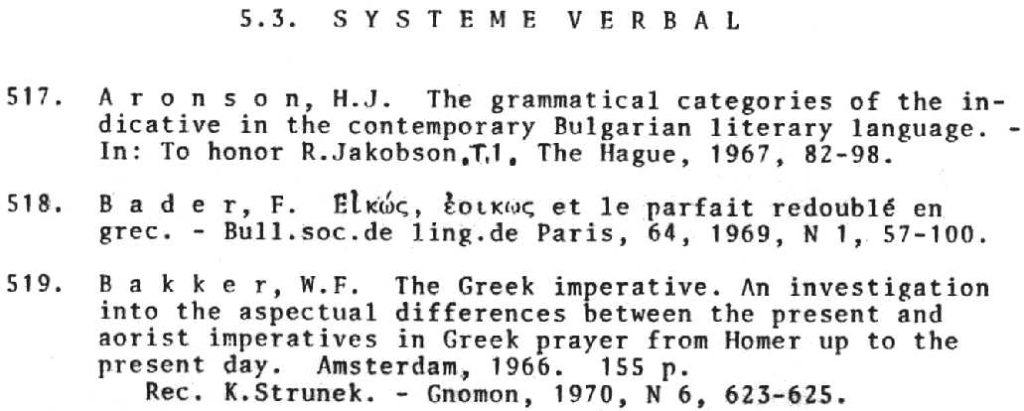

Bibliographie d’etudes balkaniques.
Sofia: Academie Bulgare des Sciences, 1966 -1988.
U of I Library Call Number: Main Stacks 016.9496 B47 1966-1970, 1975-1988 [U of I lacks 1971-1974]
This serial bibliography has citations for books and articles on all subjects related to the Balkans. There are various sections on linguistics such as dialectology, onomastics, Balkan languages, morphology, lexicology, linguistic contact, etc. There is also a section on Cyril-Methodian studies. The citations are for publications from Balkan countries, Europe, USSR, and North America and may appear in any of 17 world languages. Entries are arranged thematically with indexes for names and geographic locations. The topic arrangement is a bit different for the earlier volumes, but the geographic indexes were more detailed. There is also a list of sources which shows bibliographies, periodicals and collections from which the citations were gathered. See the image below for some of the entries that appear in volume 5 under the heading Slavic Languages.


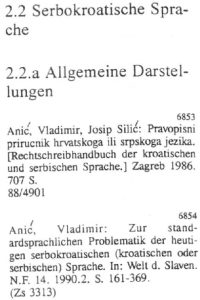
Katalog des Schriftums uber den Donauraum.
Grossheide, Ksenija. Hannover: Niedersachsische Landesbibliothek, 1987-1997.
U of I Library Call Number: Oak Street Facility 016.9496 N552k v.1-5
Although this source is really about the Danubian region, there is much information about certain Balkan countries through which the Danube flows. Citations for books and articles pertain to all aspects of the Danube countries such as politics, religion, literature, and linguistics, among others. The first and second volumes contain citations of a more general nature on the whole region plus citations on Jugoslavia. Volume 3 covers Romania, Banat and Siebenburgen (Transylvania). Volume 4 is devoted to Hungary and Volume 5 covers all of these topics for the years 1993-1996. There appears to be no chronological limits to the material included, so there are references to items published several hundred years ago, but most works are from the 20th century. There are detailed tables of contents to elucidate the subject arrangement, a list of sources, as well as an index for authors and anonymous titles. See the image below for some of the citations from volume 2 that appear under the heading Serbo-Croatian language.
Miscellaneous
ALA-LC romanization tables. Transliteration schemes for non-Roman scripts.
Barry, Randall K. Washington, D.C.: Library of Congress, 1991. 216 p.
U of I Library Call Number: General Slavic Reference 411 AL1
HathiTrust full text: http://hdl.handle.net/2027/mdp.39015025373989
Library of Congress transliteration tables are essential for research pertaining to languages written in Cyrillic or other non-Roman scripts, because most US library catalogs transliterate titles and names according to the Library of Congress scheme. A notable exception to this is the old New York Public Library Dictionary Catalog of the Slavonic Collection which uses its own scheme. ALA-LC romanization tables just presents the tables by language with notations for exceptions and obsolete characters. Each table shows the character in upper and lower case letters and the romanized equivalent. Besides Russian, Serbian and Macedonian, Bulgarian, Church Slavic, Ukrainian and Belorussian, other tables that East European scholars might need to know are Armenian, Georgian, Greek, and Non-Slavic languages in Cyrillic script.